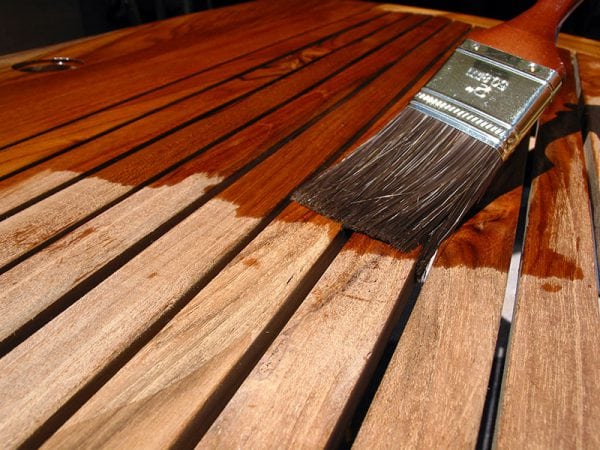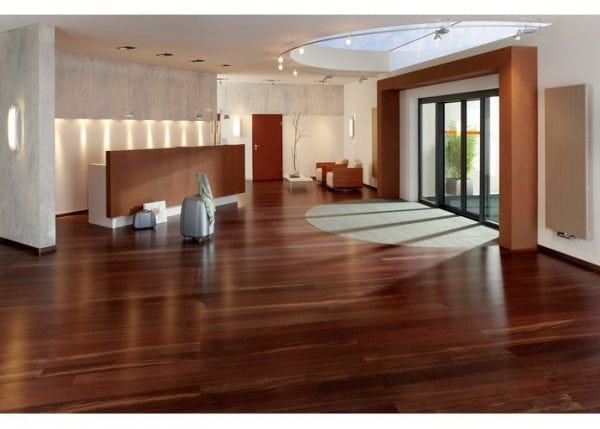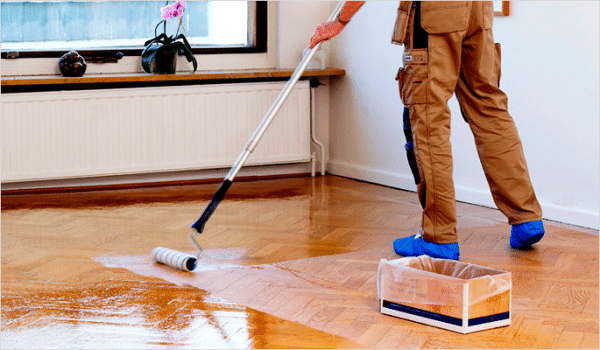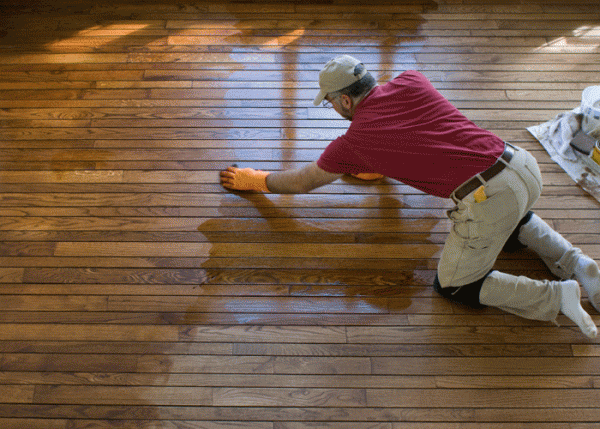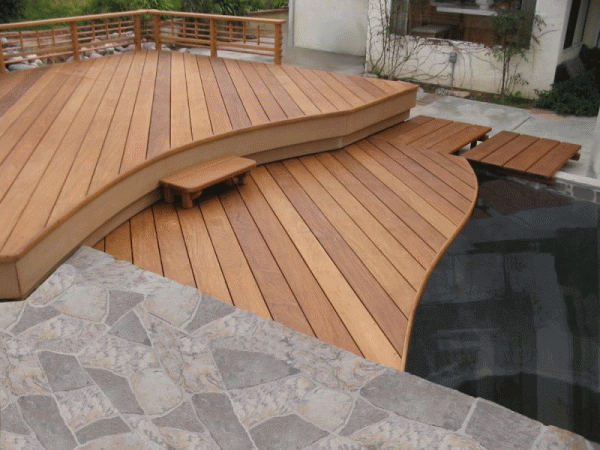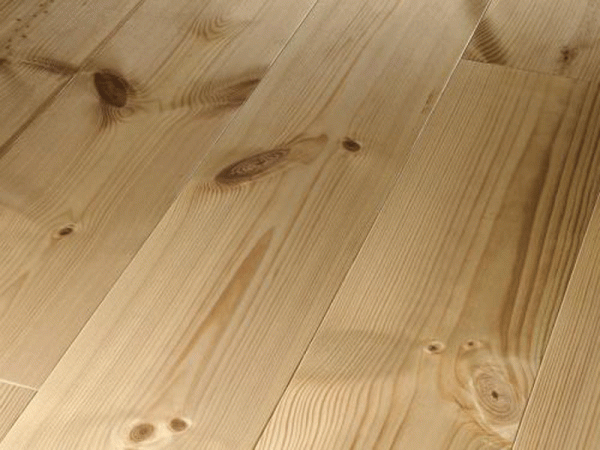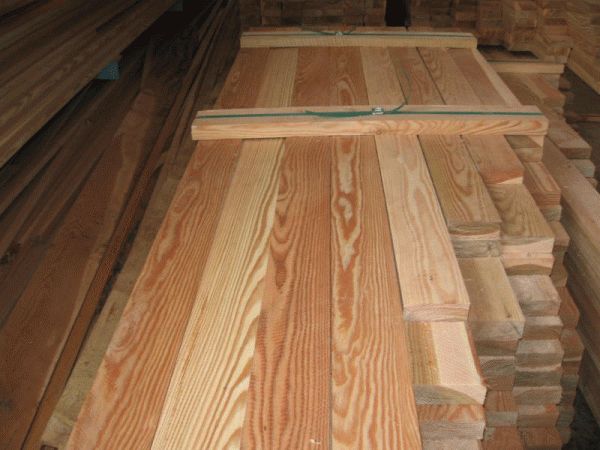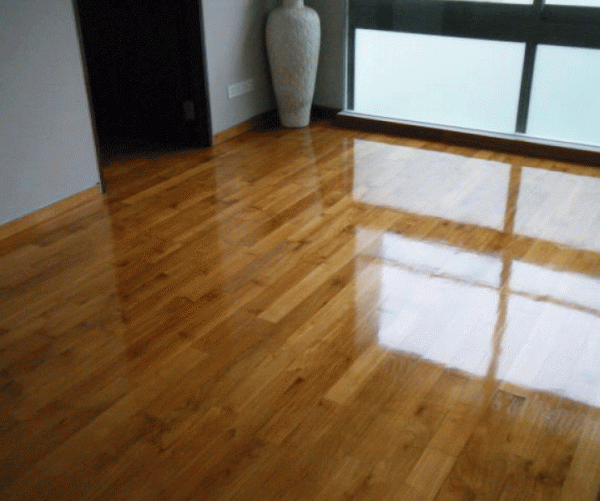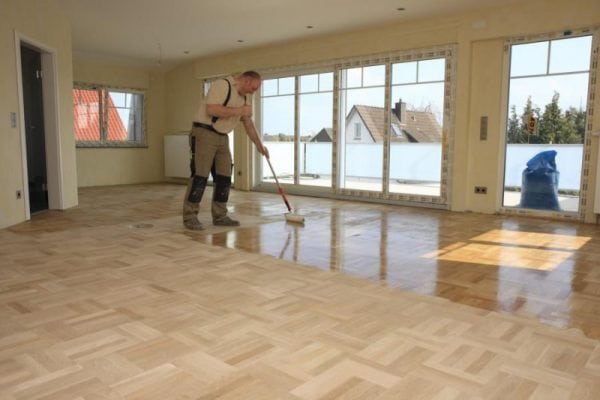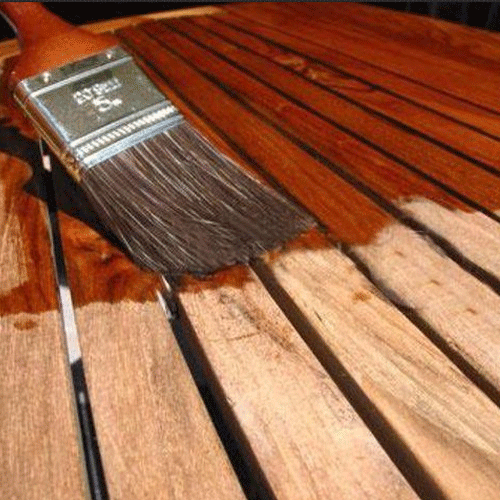Laying a new wooden floor or restoring an old one, each owner asks himself the question: “How to cover it, so that it is beautiful, durable and not too expensive?”. The choice of coatings for this purpose is huge, but to preserve the beauty and emphasize the texture of wood, it is best to use floor polish.
- What to look for when choosing
- Varieties of varnish coatings in composition
- The choice of varnish depending on the type of wood
- Larch
- Pine
- Hardwood
- Exotics
- Location matters
- Aesthetic appearance
- How to repair the floor surface yourself
- Training
- Operating procedure
- Possible problems during application
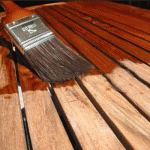
Colorless or tint varnishes for a long time will preserve the pristine attractive appearance of the wood structure, favorably shading or emphasizing its unique pattern. It is very important to choose all the parameters correctly, so that after the repair is completed, the parquet will please its beauty for a long time. And care for it will be simple: just wash it with water or with the addition of detergents.
to contents ↑What to look for when choosing
In order for a brand new or freshly repaired floor to please your eyes for a long time, not to get dark and not rot, when buying a varnish for a wooden floor, the following factors must be taken into account.
- The location of the flooring. Depending on whether the floors will be covered on the street or in the house, it is necessary to purchase a paintwork for outdoor or indoor use.
- Temperature differences. For a country house that is not heated in winter, it is better to take a varnish for the floor with a frost-resistant composition.
- Protective qualities. You need to think about whether there is a need for flame retardant and antifungal components.
- Grade of wood. What is suitable for oak may not be suitable for staining larch.
- Load. If the room has a large cross, then you need to buy wear-resistant mixtures, preferably two-component ones, consisting of a base and a hardener.
- Environmental friendliness (non-toxic and odorless varnishes are usually used for residential premises).
- The components that make up the paintwork solution.
- Appearance of varnish (colorless or tinted, matte or gloss).
- Profitability (coating service life and material consumption: how much is needed for processing one square meter).
Varieties of varnish coatings in composition
Depending on the solvent, they are divided into:
- Water soluble. Such mixtures are almost odorless, easy to care for, dry quickly and form a strong protective film as a coating. The downside is that such compounds are very fluid, penetrate deep into the wood, and after drying the varnish, the boardwalks can make an unpleasant creak. To prevent such consequences and to reduce the consumption of material during painting, the floors must first be primed.
- Soil varnishes are able to give a beautiful smooth finish. They are ideal for exotic wood, reliably protecting it from moisture and solar ultraviolet radiation. Quick drying.
- Alcohol Quick-drying, add gloss to the floor. Non-toxic, alcohol smell quickly disappears. Paint consumption is small. Medium-strength, affordable.
- Based on resins made from natural raw materials.When applied, such a coating penetrates deeply into the structure of the tree, emphasizing its uniqueness and beauty, resistant to temperature fluctuations and humidity changes.
Depending on the type of resin that the varnish for the floorboard contains, natural-based preparations can be divided into:
- Polyurethane varnish for the floor. Wear-resistant, often incorporates acrylic or urethane, durable, well suited for rooms with high traffic. Dries less than 3 hours even with high humidity. The downside is the high cost.
- Polyurethane-acrylic. The coating with an acrylic additive to polyurethane resins is less durable than polyurethane mixtures, it is used in rooms with medium and low traffic. Consumption per 1 m2 is moderate. Easy to clean: just wash it.
- Acrylic is made only on a water basis. Moisture-resistant, elastic, eco-friendly, almost odorless. Suitable for exterior and interior use, but not resistant to abrasion and mechanical damage. Economical: low price and low consumption.
- Urethane is resistant to scratches and other damage. Elastic and water repellent. Medium abrasion resistant, affordable.
- Alkyd dries quickly, but is weak and inelastic.
- Urethane-alkyd combines the positive qualities of alkyd and urethane varnishes, has increased strength and protective properties.
- Epoxy refers to a type of acid-curable. Highly toxic: to work with it, it is necessary to use protective equipment and provide good ventilation of the room. The surface painted by it can emit toxins up to three days, all this time it is impossible to stay in the room. Epoxy mixtures have increased strength, resistance to weathering and are widely used for outdoor applications.
- Urea-formaldehyde, also belong to the acid-cured group, wear-resistant, but toxic. How much drug is needed depends on the surface being treated.
In addition, varnishes are:
- one-component (consist of a solvent base and an active substance);
- two-component (hardener is added to the solvent base, which is added before use).
The choice of varnish depending on the type of wood
To beautifully and efficiently varnish the flooring, you need to correctly select the varnish for the wooden floor, taking into account the type of wood.
Larch
Larch boards have high strength, resistance to moisture and decay. Often larch is used for lining baths or saunas. Larch plank flooring is good for gazebos, porches or rooms with high humidity, such as a kitchen, bath or bathroom.
Water-soluble, alkyd or polyurethane compounds are used to cover the larch floor, acid-cured solutions are often used for outdoor applications. You can choose the optimal composition for the finish coating and the required amount for the surface of the larch board, focusing on its location (at home or on the street) and the load (throughput) of the room.
In addition, the larch board has high strength, it does not deform during operation. How many layers of coating to apply? At least two - it all depends on the composition of the drug.
to contents ↑Pine
Compared to larch, pine wood is not as strong. Therefore, the paintwork should provide it with increased protection, and ordinary parquet varnishes for this purpose are not always suitable.
Due to its soft structure, a pine board requires a more careful selection of funds for its coloring. If you neglect this and buy a cheaper option, as many do, buying floor polish in the country, then soon the varnished surface will crack, and then it will not be able to fully protect the base of pine from moisture, mold or fungus.
For painting, it is better to use urethane, polyurethane or epoxy preparations with high strength and elasticity.Pine, like other soft wood species, it is recommended to cover with several layers of paintwork. The material consumption will increase slightly, but the quality will be high.
to contents ↑Hardwood
For floors from unstable varieties of wood (beech, ash, oak) before staining, the use of special soil mixtures is necessary. After such preparation, alkyd or polyurethane compounds are applied - they will give the tree the necessary strength, protect it from moisture and mechanical damage, greatly facilitating floor care.
Exotics
Varnishing exotic tree species is best after neutralizing the essential oils they release. The neutralizer is selected depending on the breed, then the surface is primed and coated with any varnish, in accordance with the load on the floor surface and the influence of the environment on it.
to contents ↑It must be remembered: if the wood contains tannins, then the floor before varnishing is best primed. If this is not done, then the surface will soon darken with uneven spots, spoiling the beautiful appearance of the decorative coating.
Location matters
Thinking about what is the best choice for painting boardwalk, it is necessary to consider not only toxicity, drying time and wood species. It is still necessary to take into account the location of the object.
- In living rooms with moderate humidity, it is better to use aqueous acrylic solutions. They are non-toxic, harmless to the health of people and pets, easy to apply, dry quickly, have low consumption. Surfaces coated with such varnish do not require special care; they are easy to wash. If it is not possible to use water-soluble formulations, the least toxic mixtures should be selected. Surface care consists in cleaning them from contamination.
- For a bathhouse, kitchen, and also other damp rooms it is necessary to choose moisture protective varnishes with antifungal antiseptic additives. For a steam room or bath, it is better that they also contain flame retardant components. Painting is preferable to do with acrylic two-component mixtures. Two-component options have the greatest strength and do not have toxic substances in the composition.
- For closed verandas and summer houses not heated in winter, it is advisable to choose a frost-resistant mixture for outdoor work.
- When painting the flooring in the gazebo or on an open boardwalk during outdoor work, drugs with increased strength should be chosen. For this purpose, you can use deck (boat) varnish - it is high strength, used for painting boats. It can also be used for external painting of products that are outdoors and exposed to adverse external factors (rain, wind, snow). How many application layers will it take? At least two, but more.
Aesthetic appearance
In addition to protective and strength qualities, an aesthetic side is also important during repair, because it is it that creates the mood and helps to give the room a unique look. In this case, the choice of means depends only on how the floor should be.
The gloss of the coating can be divided into:
- glossy - suitable for a board with an unusual wood pattern;
- matte - emphasize and preserve its beauty for a long time.
By painting, varnishes are:
- Colorless. When applied, the tree acquires a luster or a dull sheen.
- Colored, giving the wood the necessary shade, emphasizing or shading its unusual texture. Sometimes such tinting is done with one's own hands: the master himself adds dye to a colorless solution, periodically checking on a wooden sample with a brush what the shade of the floor should be.
How to repair the floor surface yourself
Having decided what composition you need to purchase in order to be beautiful, durable and inexpensive, you can proceed to finish the floor with your own hands. This requires such tools.
- Polishing machine. It can be purchased, but it will be cheaper to rent, because if all the work is done correctly, then the device will not be needed again soon.
- Abrasives of various denominations, while the presence of the highest and softest numbers is required.
- Spatulas.
- Application tool. Best of all, the varnish is distributed by a roller, but it is necessary to stock up with various brushes to smear corners and hard-to-reach spots.
- Soft rags to remove excess makeup.
- Cleaning equipment to remove all dirt before work.
Training
Necessary conditions for high-quality work:
- The room must have a temperature corresponding to the parameters specified in the instructions for the mixture to be purchased. Exceeding or not achieving these parameters will affect the quality of the final result (strength, durability).
- Humidity. High humidity is needed only for water-soluble mixtures, in others it causes a violation of drying and the formation of a protective film. When used for outdoor work, it will be precipitation.
- Drafts. Airing is allowed only when working with acid-curable compositions, in other cases, this leads to a deterioration in the quality of work.
Operating procedure
How do I do the repair myself?
- First, the surface is prepared properly. To do this, it must be cleaned of dirt and remove the old coating. Removing the previous layer can be done with a spatula or grinder (grinder).
- After removing the old decorative layer (if restoration was carried out), the surface is cleaned with a grinder with a special nozzle or sandpaper of different softness. You need to remove all the bumps.
- If the floor is old, after the layers of peeling paint have been removed, it must be leveled with putty or recycled.
- You can cycle the floor surface with your own hands or resort to the help of an experienced craftsman. But it is worth remembering that if you do not succeed in cycling correctly, then the parquet will be damaged. Maybe it will be more profitable to hire a master?
- After this, it is necessary to remove all garbage, to improve the quality of such a floor, it is even better to wash it, only then you need to let it dry.
- Now, if the floor is old, uneven or the wood needs protection, a primer should be applied. With your own hands, it is applied using a spray gun or roller, and hard-to-reach spots are painted over with a brush. All surplus, how much they turned out, must be removed with a soft cloth.
- Now you can open the jar with varnish or mix the components (if two-component mixtures are used). If desired or necessary, tint with your own hands after opening the can of paint.
- It is better to apply the preparation after preparing and washing the surfaces with a roller, working in parallel and perpendicularly, applying the composition in one direction and leveling it in the other. It is necessary to apply as many layers as drying, as recommended in the manufacturer's instructions or a little more.
- After that, after a day or more, depending on the speed of drying, it will be possible to vacuum and mop the floor. Further surface care will be simple.
Possible problems during application
Sometimes there are problems with the coating. This happens for the following reasons:
- The varnish does not dry. It either does not fit the type of wood used, or requires a different temperature drying regime. If not suitable, then it will have to be removed, removed using a grinding machine, then applied again.If the problem is in temperature, then it should be brought to the required minimum.
- There was not enough hardener in the two-component varnish. In this case, it is necessary to remove (by polishing) the unsuccessful coating and apply again.
When deciding which varnish to choose for repair, each owner will be able to choose the one that will be economical, easy to care for, and relatively durable. Perhaps you should buy a more expensive composition that will protect and decorate the wood for several years, than to get cheaper for a year? How much is the extra cost?
For several years, properly covered floors will only need to be washed; they do not need more care. The main thing is not to be too lazy and apply as many layers of the product as shown in the instructions, or 1-2 more.

